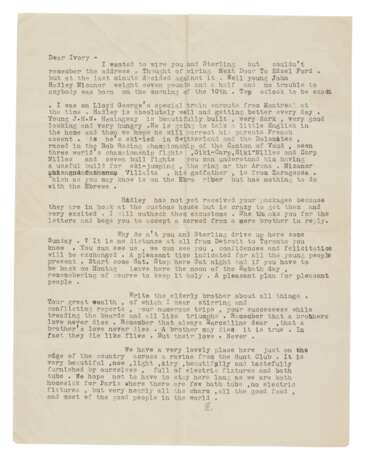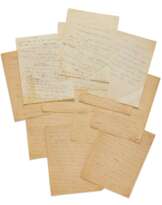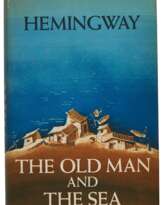Hemingway, Ernest | Typed letter to Marcelline, announcing the birth of his first son and the publication of his first book
08.12.2023 12:00UTC -05:00
Classic
Prix de départ
25000USD $ 25 000
| Auctioneer | Sotheby´s |
|---|---|
| Lieu de l'événement | Etats-Unis, New York |
Archive
La vente aux enchères est terminée. Vous ne pouvez plus enchérir.

ID 1105466
Lot 19 | Hemingway, Ernest | Typed letter to Marcelline, announcing the birth of his first son and the publication of his first book
Valeur estimée
$ 25 000 – 35 000
Typed letter with typed signature only ("Immer Bruder"), to his sister Marcelline Hemingway Sanford ("Dear Ivory"), soliciting her "solemn pledge" to keep word of the publication of Three Stories and Ten Poems from the rest of their family
2 pages (268 x 210 mm) on two sheets of typing paper, [Toronto, postmarked 14 October 1923], accompanied by the original typed envelope directed to "Madame Sterling Sanford" with typed address in Detroit, Michigan, emended in Hemingway's hand to their parents' address in Oak Park, Illinois; tiny pinhole at central intersecting folds of each sheet, envelope browned.
"CONFIDENTIAL … THREE STORIES AND TEN POEMS … is out and all sold out the first edition." An exceptional letter: Hemingway announces both the birth of his first son and the publication of his first book and reports that his second book, in our time, is at the printers.
The Hemingways had returned to Toronto from Paris in early September 1923 in order for Hadley to have a baby. Ernest was able to find a reporting job again at the Toronto Star and the couple planned to stay a year or more (they would escape back to Paris after only four months). "I wanted to wire you and Sterling but couldn’t remember the address. Thought of wiring Next Door to Edsel Ford [whose mansion neighbored the Sanfords’ apartment building], but at the last minute decided against it. Well young John Hadley Nicanor [later nicknamed "Bumby"] weight seven pounds and a half and no trouble to anybody was born on the morning of the 10th. … I was on Lloyd George’s special train enroute from Montreal at the time [Hemingway was covering the Prime Minister’s trip to New York]. Hadley is absolutely well and getting better every day. Young J.H.N. Hemingway is beautifully built, very dark, very good looking and very hungry. He is going to talk a little English in the home and then we hope he will correct his parents French accent." Hemingway then gives a joking recitation of all that his son had supposedly already experienced in utero: skiing, bobsledding, and attending three world championship fights and and seven bullfights. He also mentions the matador Nicanor Villalta, the inspiration for one of the baby’s middle names.
The letter continues in a domestic vein: “Why don’t you and Sterling drive up here some Sunday? It is no distance at all from Detroit to Toronto you know. You can see us, we can see you, confidences and felicitations will be exchanged. … Write the elderly brother about all things. Remember that a brother’s love never dies. Remember that always Marcelline dear, that a brother’s love never dies. A brother may die it is true. In fact they die like flies. But their love. Never. We have a very lovely place here. … It is very beautiful, new, light, airy, beautifully and tastefully furnished by ourselves, full of electric fixtures and bath tubs. We hope not to have to stay here long as we are both homesick for Paris where there are few bath tubs, no electric fixtures, but very nearly all the charm, all the good food, and most of the good people in the world."
The tone of the letter changes abruptly as the entire second page is devoted to a proud discussion of his first two books: "CONFIDENTIAL. One of my books, THREE STORIES AND TEN POEMS, pooblished [sic] by the Contact Publishing Company is out and all sold out the first edition [300 copies were published on 13 August]. I took great care to keep this from reaching relatives due to the first story which is a whangleberry but would simply shock and give them that familiar [']I’d rather see you dead and buried in your grave than—feeling.' It is a corking story and I am very proud of it but there is no sense making trouble." The story, "Up in Michigan," describes a date rape. In the "Miss Stein Instructs" chapter of A Moveable Feast, Hemingway writes that Stein told him that its frank sexual content made the story "'inaccrochable. That means it is like a picture that a painter paints and then he cannot hang it when he has a show and nobody will buy it because they cannot hang it either.'"
Clearly sensitive to the reaction his parents would have to the story, Ernest entreats Marcelline, "If you give me your solemn pledge that it will not fall into the hands of any of the family, your solemn pledge on your word of honor, I will put you into the way of obtaining a copy."
His other book, he continues, does not have to be embargoed from the other Hemingways: "Book No. 2 IN OUR TIME—originally announced under the Title of Blank—which I believe you have ordered. Is in the printers hands now. It is a whangleberry and I don’t care who sees it. It will give them a jolt but mores the good. You should get it in a month or so. The illustrations and borders are taking time. I just received a cable about it from Partis yest. There is, I believe, a frontispiece of yauthor painted by Mike Strater who is miles ahead of all the rest of the pigmenters. The book is published by THE THREE MOUNTAINS PRESS." in our time was published in Paris in March 1924. As noted by the editors of The Letters of Ernest Hemingway, "In fall 1922, when Bird printed the prospectus for the Inquest series, EH was away from Paris covering the Greco-Turkish War for the Star. Not knowing the title of the volume that EH would contribute, Pound was forced to put 'Blank' after EH’s name. The advertisement reached EH's parents, and they, unbeknownst to each other, separately wrote to Pound in November 1922 to each order five copies of the new book 'Blank'" (p. 64, note 6).
Hemingway tells his sister than he has even more work appearing in print. "If you want to see some more of my stuff THE EXILES NUMBER OF THE LITTLE REVIEW—just out—Price $1.00 and obtainable in Detroit I believe. Has the Leading thing by E.M.H. and another [his poem "They All Made Peace—What Is Peace?"]. The stuff that opens the number are the first six chapters of IN OUR TIME. There is also a very good things by Gertrude Stein, some nice drawings by Leger and a story by Bob McAlmon. The number is worth the paper seed. Now remember that the above in regard to Three and Ten is given you absolutely confidentially. Let the family in on les autres." Hemingway ends by providing his and Hadley’s home address, but asks that letters be sent to him care of the Toronto Star.
Marcelline kept Ernest’s confidence regarding Three Stories and Ten Poems, as she assured him in her response of 20 October: "True to form I reserved the last page for myself and husband, and signed a spurious initial 'E' to the end of the first page because, having received it in the parental home & all that, I knew it would not be kept away from the father's eye." Marcelline’s penciled “E” is still visible at the bottom of the first page.
| Artiste: | Ernest Miller Hemingway (1899 - 1961) |
|---|---|
| Catégorie maison de vente aux enchères: | Impressions, graphiques, livres |
| Artiste: | Ernest Miller Hemingway (1899 - 1961) |
|---|---|
| Catégorie maison de vente aux enchères: | Impressions, graphiques, livres |
| Adresse de l'enchère |
Sotheby´s 1334 York Avenue 10021 New York Etats-Unis | ||||||||||||||
|---|---|---|---|---|---|---|---|---|---|---|---|---|---|---|---|
| Aperçu |
| ||||||||||||||
| Téléphone | +1 212 606 7000 | ||||||||||||||
| Conditions d'utilisation | Conditions d'utilisation | ||||||||||||||
| Heures d'ouverture | Heures d'ouverture
|












